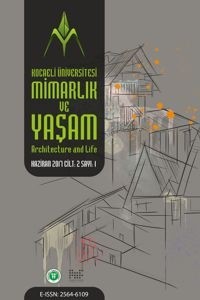Peyzaj Mimarlığı Eğitiminde Doğaya Öykünme Yaklaşımının Yaratıcılık Üzerindeki Etkisi
Peyzaj mimarlığı; insanların ihtiyaç ve istekleri doğrultusunda açık mekânlar tasarlayan bir disiplindir. Peyzaj mimarları açık mekânları tasarlarken öncelikle kullanıcı odaklı, birbirinden farklı ve yaratıcı tasarımlar ön plana çıkarmalıdır. Bu nedenle peyzaj mimarlığı eğitiminde öğrencilere, tasarım ve yaratıcılık becerisi kazandırabilecek yaklaşımların öğretilmesi gerekmektedir.Bu çalışmada, Karadeniz Teknik Üniversitesi Peyzaj Mimarlığı 4. Yarıyılda verilen ‘Doğal Yapılar ve Tasarım’ seçmeli dersinin, öğrencilerin yaratıcılığını geliştirmedeki etkisini belirlemek amaçlanmıştır. Dersin asıl amacı öğrencilere, problemlere yönelik doğada sonsuz sayıda, yol gösterici, mükemmel tasarımlar olduğunu ve bunlardan esinlenerek işleve uygun yaratıcı tasarımlar yapabileceklerini öğretmektir. Böylece günümüzün en büyük problemlerinden biri olan birbirinin aynı olan ve bir kimliği olmayan açık mekânların tasarlanma nedenleri temelden öğrencilere öğretilmiş olur ve bu sorunun çözümüne yönelik tasarımlar yapmaya teşvik edilirler. Bu bağlamda, ‘Doğal Yapılar ve Tasarım’ seçmeli dersini alan (30) ve dersi almayan (30) öğrencilere, proje derslerinde yaratıcı tasarımlar yapabilmeleri ile ilgili hazırlanan bir anket yapılmıştır. Böylelikle dersi alan öğrenciler ile almayan öğrencilerin yaratıcılık düzeylerinde farklılık olup olmadığı belirlenmeye çalışılmıştır. Sonuçta doğuya öykünme yaklaşımını bilen öğrencilerin, bilmeyen öğrencilere göre yaratıcı tasarımlar yapmakta daha az zorlandıkları ortaya konmuştur.
Anahtar Kelimeler:
Doğaya öykünme, peyzaj mimarlığı eğitimi, yaratıcılık
The Influence of Natural Inspiration Approach on Creativity In Landscape Architecture Education
Landscape architecture is a discipline that designs open spaces for people's needs and preferences. When designing open spaces, landscape architects must first focus on user-focused, distinctive and creative designs. For this reason, landscape architectural education should be taught to students about design and creativity skills. In this study, it is aimed to determine the effect of the 'Natural Structures and Design' course to improve the creativity of the students; that is taught in the 4th semester during the education in the Department of Landscape Architecture in Karadeniz Technical University is examined. The main aim of the course is to teach the students that there is an infinite number of guiding, perfect designs for the problems in the nature, and that they can inspire and design appropriate creative designs. Thus, the reasons for designing open spaces that are one of the greatest problems of ours, which are the same and which are not an identity, are taught to students on a basis and encouraged to design solutions to this problem. In this context, a questionnaire was prepared for students who did not take the 'Natural Structures and Design' elective course (30) and those who did not take the course (30) to make creative designs in project courses. Thus, it has been tried not to determine whether there is any difference in the creativity levels of the students taking the course or not. As a result, it was revealed that students who know the nature emulation approach are less able to make creative designs according to the students who do not know.
___
- Abra, J,. The Motives for Creative Work, Hampton Press, Cresskill, New Jersey, USA 1997.
- Alexander, C., Notes on the Synthesis of Form, Harvard University Press, Oxford 1964.
- Anderson, J., Basics Architecture 03: Architectural Design. Switzerland: AVA Publishing SA 2011.
- Apaydın, B., Eğitimci Gözüyle Tasarımda Yaratıcılık Söylemi. The Turkish Online Journal of Design, Art and Communication. 5(3), 2015,s.12-21.
- Selçuk, A., Sorguç, A., Mimarlık Tasarımı Paradigmasında Biomimesis’in Etkisi. Gazi Üniversitesi Mühendislik-Mimarlık Fakültesi Dergisi, 22(2), 2007, s. 451-459.
- Asimow, A., Introduction to Design, Prentie-Hall, New York 1962.
- Ayıran, N., Mimari Tasarlama Sürecine ve Yapma Çevrenin İnsan ve Toplum Üzerindeki Etkilerine Yaratıcılık Bakış Açısından Bir Yaklaşım, Doktora Tezi, İTÜ Mimarlık Fakültesi.1983.
- Ball, L.J., Christensen, B.T. Analogical Reasoning And Mental Simulation İn Design: Two Strategies Linked To Uncertainty Resolution. Design Studies, 30, 2009, s.169- 186.
- Ball, L.J., Ormerod, T.C., Morley, N.J. Spontaneous Analogising İn Engineering Design: A Comparative Analysis Of Experts And Novices. Design Studies, 25,2004, s. 495-508.
- Bayazıt, N., Endüstri Ürünlerinde ve Mimarlıkta Tasarlama Metotlarına Giriş, Literatür Yayıncılık, İstanbul, Türkiye, 1994.
- ISSN: 2564-6109
- Başlangıç: 2016
- Yayıncı: Kocaeli Üniversitesi
Sayıdaki Diğer Makaleler
Kentsel Açık Mekanlarda Kadınlar: Cinsiyet Rollerinin Kamusal Alanlarda Gözlemlenmesi
Sema Mumcu, Serap Yılmaz, Tuğçe Yazıcı
Türk Daması Oyun Kültürü Ve Türkiye’deki Dama Oynanan Kahvehanelerin İç Mekânlarının İncelemesi
19. Yüzyıl Türk Sivil Mimarisinde Duvar Resmi Estetiği ve İstanbul Teması
Didem ERTEN BİLGİÇ, Nihan KONAK
İnşa Kuralları, Mimari Algı ve Mekan Kullanımı Bağlamında Osmanlı Toplumunda “Cumba”/ “Şahnişin”
Zeynep Gamze Mert, Filiz Ertürk
Sinema-Mimarlık Arakesitinde Cyberpunk (Siberpunk) ve “Ada” Filmi Üzerinden Eleştirel Bir Yaklaşım
Peyzaj Mimarlığı Eğitiminde Doğaya Öykünme Yaklaşımının Yaratıcılık Üzerindeki Etkisi
